Tag archives: fluid mechanics
The hi-tech way to cycle more easily
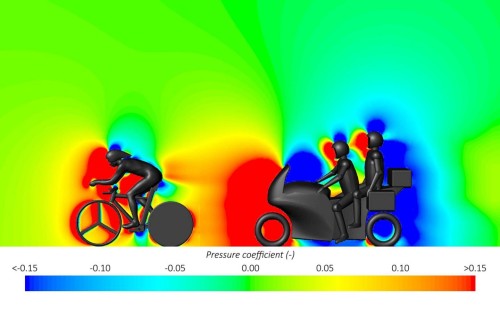
Easy does it: this computer simulation of a motorbike following a cyclist shows a drop in pressure (red area) that cuts the aerodynamic drag on the cyclist by almost 9%. (Courtesy: Eindhoven University of Technology)
By Matin Durrani
Some of the world’s top cyclists are gathering today in the Dutch city of Apeldoorn to take part in the opening stage of the 2016 Giro d’Italia – the 99th running of a race that is one of the three big European professional cycling stage races, along with the Tour de France and the Vuelta a España.
Today’s stage is a short (10 km) time trial and will be followed by two, longer stages in the Netherlands before the action moves to Italy, where the race is due to end on 28 May in Turin. Now, even if you have no interest in cycling – and mine stretches no further than tootling back and forth to work each day – one thing that looks truly scary about professional cycle races such as the Giro d’Italia is the phalanx of motorbikes following in the wake of the cyclists.
These motorbikes can carry everyone from TV camera operators and press photographers to doctors, traffic managers and support staff, all keen to keep as close as possible to the action. Now, however, researchers in the Netherlands and Belgium have discovered that having a motorbike right behind a cyclist could give the latter an advantage. Led by Bert Blocken, a physicist in the Department of the Built Environment at Eindhoven University of Technology, the study reveals that a motorbike at a distance of 25 cm behind a cyclist can cut aerodynamic drag on the person on the bicycle by almost 9%. That amounts to a reduction of almost 3 s for every kilometre travelled. (more…)
Dipping into the physics of a chocolate fountain
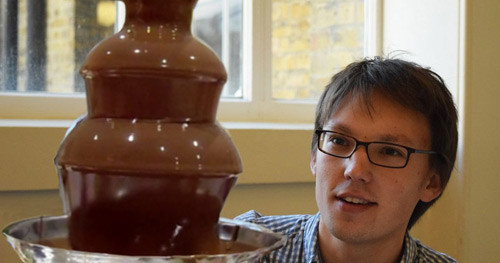
Dark flow: Adam Townsend ponders the dynamics of a chocolate fountain. (Courtesy: London Mathematical Society)
By Tushna Commissariat
When most people look at a chocolate fountain in a restaurant or maybe at a party, they are mostly thinking about all the yummy treats they can dunk into the liquid-chocolate curtain. But when a physicist or a mathematician looks at one, they can’t help but notice some of the interesting fluid dynamics at play – most visible is how the curtain of chocolate does not fall straight down, rather it pulls inwards, and that melted chocolate is a non-Newtonian fluid.
University College London (UCL) student Adam Townsend decided to work on this topic for his MSci project and has now published a paper on his findings in the European Journal of Physics. To study the inflow effect, he looked into some classic research on “water bells”, where the same flow shape is seen. “You can build a water bell really easily in your kitchen,” says UCL physicist Helen Wilson, who was Townsend’s MSci project supervisor and the paper’s co-author. “Just fix a pen vertically under a tap with a 10p coin flat on top and you’ll see a beautiful bell-shaped fountain of water.”
View all posts by this author | View this author's profile
Why are rectangular pipes like circular pipes?

Go with the flow. (Courtesy: iStockphoto/Inok)
By Matin Durrani
Consider a spherical cow.
No, wait, actually, let’s try something different. Consider a rectangular pipe.
In fact, consider what happens when liquid flows along a rectangular pipe, by which I mean one with a rectangular cross section. The flow’s bound to be asymmetrical, right?
Yes, that’s true, but not always. New research published in Physical Review Letters suggests that for liquid flowing along a rectangular pipe that’s exactly 1.87 times wider than it is high, the flow is entirely symmetrical.
Now, I’ll admit that water flowing along a pipe is probably not something that keeps you awake at night, but the new discovery is weird. In fact, Roberto Camassa from the University of North Carolina, Chapel Hill, who was involved in the study, calls it “bizarre”.
View all posts by this author | View this author's profile
A visit to an island called Nuuk
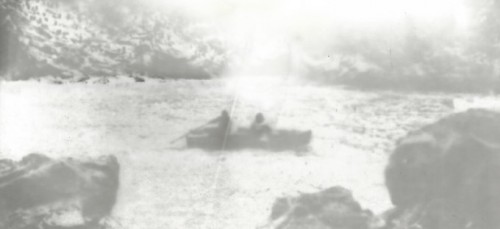
Anaïs Tondeur in collaboration with Jean-Marc Chomaz, Paul Syrillin, 2014, shadowgram, 11 × 24 cm. Image courtesy of the artist and GV Art gallery.
By Margaret Harris
The story of Nuuk began in the early 18th century when a French naval officer landed on a barren, ice-covered island and noted its coordinates in his logbook. The island, he reported, was volcanic in nature, but little else was known about it; indeed, later visitors to its supposed location found no sign of land. Rediscovered in the 20th century, Nuuk was soon visited by a series of scientific expeditions, one of which noted that the island’s surface area was shrinking. An observation station was set up on a prominent headland, but in 2012, it abruptly ceased transmitting; satellite images later revealed that Nuuk had vanished entirely beneath the ocean surface. Coincidentally, the final signal from Nuuk arrived just as the 34th International Geological Congress was meeting in Australia to discuss the emergence of a new, human-influenced geological age: the Anthropocene.
Nuuk and the various forces that contributed to its demise are the subject of a fascinating exhibition currently on show (until 29 November) at the GV Art gallery in London. Lost in Fathoms is a collaboration between an artist, Anaïs Tondeur, and a physicist, Jean-Marc Chomaz, who specializes in fluid dynamics. To develop her ideas about Nuuk, Tondeur spent a year in residence at Chomaz’s Laboratoire d’Hydrodynamique at the Ecole Polytechnique in France, while other parts of the exhibition grew out of a summer school in Cambridge, UK, that focused on fluid dynamics, sustainability and the environment.
Robotic cowboys and clams, the SQUID at 50 and more
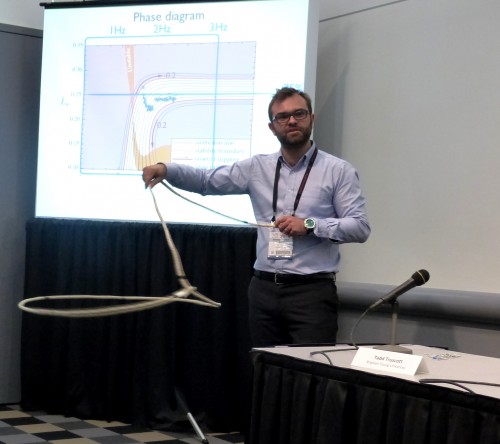
Pierre-Thomas Brun shows off his lassoing skills.
By Tushna Commissariat at the APS March Meeting in Denver
It has been another exceedingly busy day the APS March Meeting – there were sessions on the SQUID’s many applications, robotic clams, global health physics and the spread of epidemics, and even some toys based on physics principles. Here’s another quick round-up of the fascinating talks.
On SQUID row
It’s the 50th birthday of the superconducting quantum interference device or SQUID – a very sensitive magnetometer that accurately measures extremely subtle magnetic fields – this year, and there were sessions this morning to discuss its impact to date as well as possible future applications. Kent Irwin from Stanford University discussed how superconducting photon detectors that are used in a host of astronomical and cosmological observations are being amplified using SQUIDs. Such SQUID-boosted sensors are being used to make more accurate measurements of the cosmic microwave background (CMB) – to look at its power as well as certain polarizations modes it exhibits. As certain experiments look for signs of gravitational waves in in the CMB polarization, this could be particularly helpful.
View all posts by this author | View this author's profile
Why do beer bottles foam when struck on top?
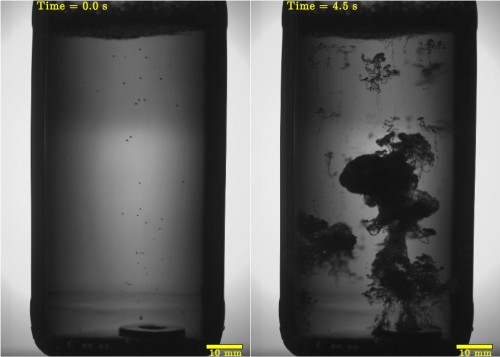
A foamy mess in the making. (Courtesy: Javier Rodríguez-Rodríguez)
By Hamish Johnston
We’ve all had a friend who does it – you’re deep in conversation at a party, beer bottle in hand, when someone sneaks up and taps the top of your bottle with theirs, causing a foamy mess to erupt from your bottle. And to add insult to injury, their bottle doesn’t foam.
Now, physicists in Spain and France have studied this curious effect and gained a better understanding of how it occurs. While their work won’t prevent wet shoes and slippery floors at university social gatherings, the researchers believe their work could provide insights into geological features such as oil reservoirs, mud volcanoes and “exploding lakes”.
Waiter, there’s a bug in my cocktail!
By Hamish Johnston
Just in time for Christmas, researchers at the Massachusetts Institute of Technology (MIT) have unveiled the ultimate “cocktail accessory”. It’s an edible self-propelled boat that whizzes around on the surface of an alcoholic drink.
Days out at CERN, serendipitous songs, shaken scientists and more
By Tushna Commissariat
A peek into the Red Folder this week brings up the CERN Open Days – the biggest particle-physics laboratory in the world will allow people from all over the globe to roam its hallowed halls freely for this weekend. While the most exciting part of the event will undoubtedly be visits into the underground caverns that host the Large Hadron Collider’s experiments, a whole host of other activities for researchers, science enthusiasts and children are available. Also this weekend, as a part of the European Researcher’s Night festivities, CERN will be hosting events in Paris, Geneva and Bologna for their Origins 2013 event that looks at two big scientific discovers made in the past two years: the discovery of the Higgs boson at CERN and the latest Planck mission data. For those of you attending, “Speed-dating – close encounters with researchers” definitely caught our eye. Those of us not fortunate enough to be in any of those places can watch many of the festivities via a live webcast. And lastly, you can explore CERN from the inside on Google Maps with Street View.